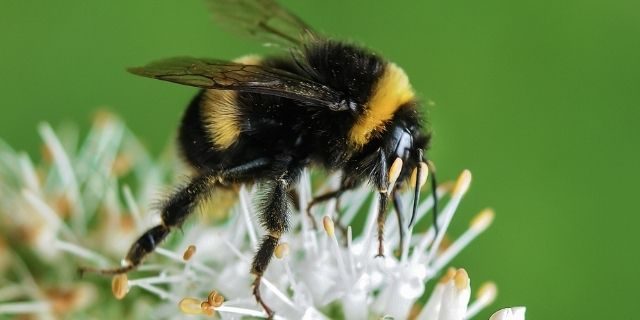13
Jul
Conservation Genomics Pinpoint Pesticides and Pathogens in Decline of Bumblebees

(Beyond Pesticides, July 13, 2021) Bumblebees exposed to pesticides and pathogens display changes in gene expression that can be pinpointed and analyzed by cutting edge research tools, according to scientists at York university, who utilized the new technique in a study published in Molecular Ecology. This form of next-generation gene sequencing is part of a growing field of science known as conservation genomics, in which entire animal genomes are sequenced to determine conservation problems. “Next-generation sequencing is a totally new way to think about why bees are declining, which could revolutionize conservation biology,” says study coauthor Amro Zayed, PhD, associate professor in biology at York. “We’re looking directly at bee tissues to try and get clues to the stressors that are affecting this bee. I think this is a gamechanger for sure. With a single study, we are able to implicate a couple of really obvious things we’ve talked about for years – pathogens and pesticides – in the case of Bombus terricola.”
Researchers focused on Bombus terricola – the yellow banded bumblebee, as its range has declined significantly over the last two decades. The bumblebee was once common throughout the eastern and midwestern part of the U.S. and Canada, but many states have not recorded a single sighting in years.
To determine what environmental stressors were affecting bumblebee gene expression, worker bees were found and collected in Southern Ontario. Eighteen bees were collected from agricultural sites while 12 were from nonagricultural areas; only 30 workers were collected in total in order to lessen the impact on the overall population. The gene analysis was conducted, and able to qualify nearly 9,500 gene expressions in bumblebee guts.
Researchers discovered 61 differentially expressed genes, including those involved in detoxification, as well as those associated with neurodegenerative disorders and immune response. Most of these effects were discovered in bees found in agricultural areas. Bumblebee gene expressions were then compared to how honey bee genes respond when exposed to stressors in the lab (most research available on bee stressors have focused on honey bees). Overlap between the differentially expressed genes analyzed by the next generation sequencing and previous honey bee research found statistically significant overlap in a number of concerning areas. Bumblebees display gene expressions that are associated with exposure to neonicotinoid insecticides, fipronil, and a range of pathogens, including deformed wing virus and sacbrood virus.
“Bumblebee diseases are a key threat and this technology can help us detect new diseases and stressors quickly so we don’t lose species the way we did the rusty-patched bumblebee, where the problem was only detected when it was too late to do anything about it in Canada,” says coauthor Sheila Colla, PhD, associate professor in conservation science at York. “The rusty-patched bumblebee hasn’t been spotted in Canada since 2009.” In the U.S., the rusty-patched bumblebee was listed as endangered in 2017, as populations have declined by an estimated 91% from its levels in the 1990s.
This new approach to conservation genomics allows for quick investigation of stressors occurring in the field. “It bypasses all these lengthy experiments we’d have to do to get ideas about what’s causing the bumblebees demise,” said Dr. Zayed. The present study provides confirmation that bumblebees are being exposed and affected by toxic pesticides. It provides evidence for the idea that pathogens from managed bumblebee and honey bee colonies are spilling over into wild pollinator populations.
Previous research has found that the combined effect of pesticides and pathogens result in greater harm to pollinators. A 2015 report by the European Academies Science Advisory Council found, “Several studies have demonstrated synergistic effects of neonicotinoid residues with bee parasites and viruses. Some effects are behavioral (e.g. blocking the ability of bees to sterilize the colony and their food). Others appear related to limiting the immune response leading either to earlier infection or to increased mortality from infection. Very recent work has shown that the limitation of the immune response after exposure to neonicotinoids can promote viral replication, allowing covert infections to become overt. Such effects reduce honey bee survival and increase developmental deformities. In view of the emphasis placed by some reviewers on assigning honey bee losses to diseases and parasites, this is a critical issue.”
While the European Union acted on this information to suspend and then eventually ban the outdoor use of neonicotinoid insecticides and fipronil due to pollinator risks, U.S. regulators have done little to address pollinator declines, and earlier this year Canadian regulators began to backtrack on their proposal to prohibit use.
With overwhelming evidence that pollinators are being harmed by these pesticides, the public continues to watch in real time as critically important species of wild pollinators slowly fade out of existence. In addition to the rusty patched and yellow banded, the iconic American Bumblebee has lost 89% of its population over the last 20 years. Eastern monarchs have declined by 80% since the 1990s. Western monarch numbers are in the low thousands, and without change, trending toward extinction.
Help pollinators by calling on your elected representative in Congress to cosponsor the Saving America’s Pollinators Act (SAPA). If they are already a cosponsor, you’ll be able to send a letter thanking them for their leadership on this critical issue. Please consider following up with a phone call in order to elevate this message to potential cosponsors. For more information on the importance of protecting pollinators from pesticides and other environmental stressors, see Beyond Pesticides’ Bee Protective webpage.
All unattributed positions and opinions in this piece are those of Beyond Pesticides.










